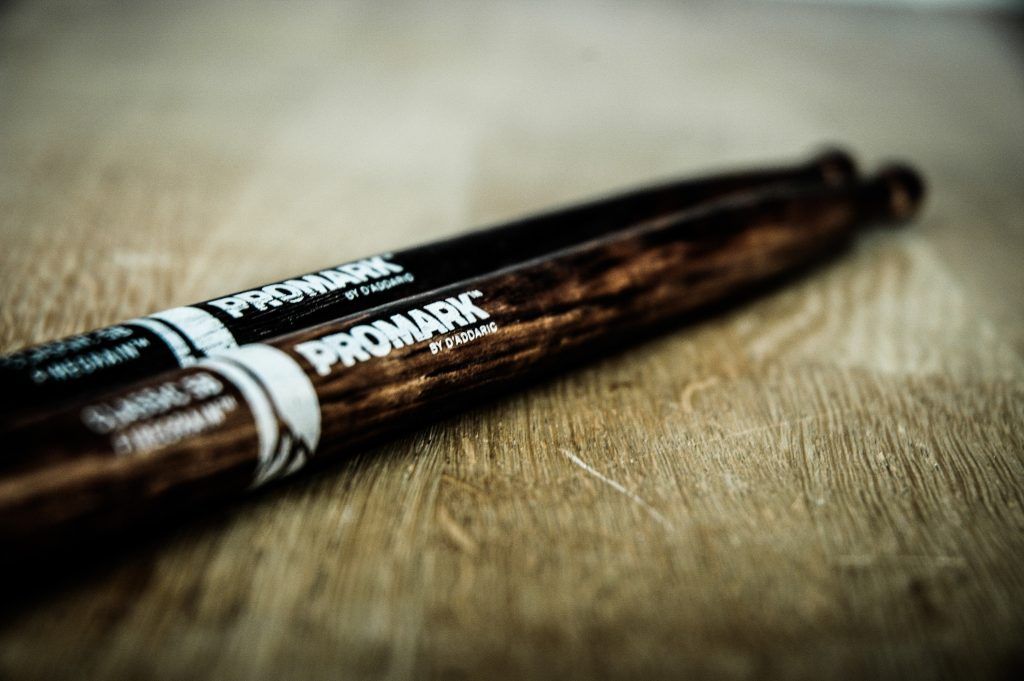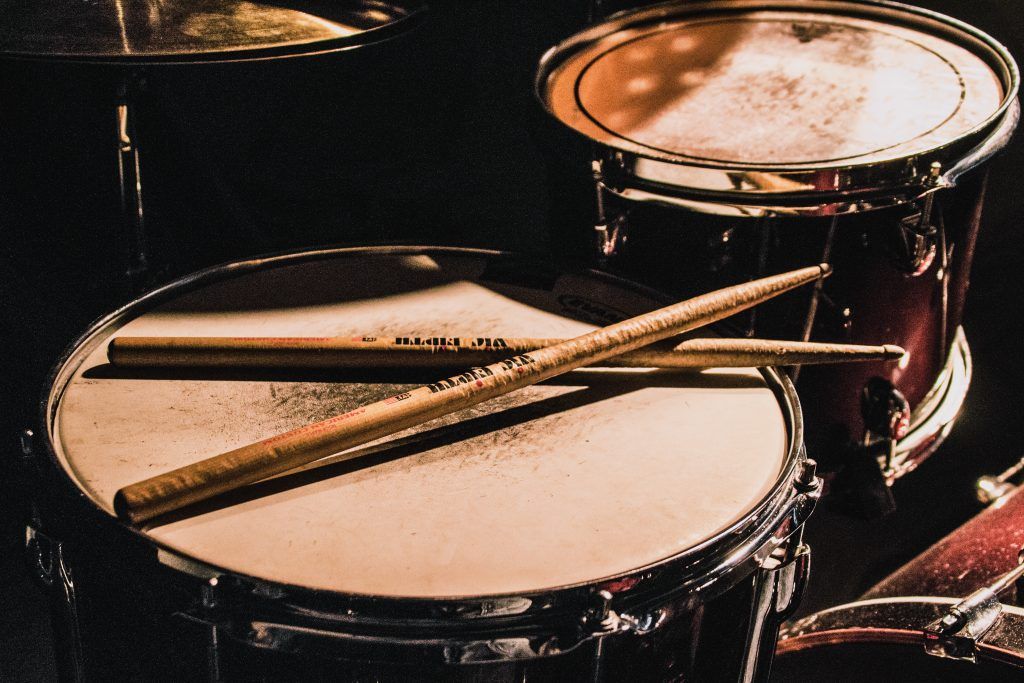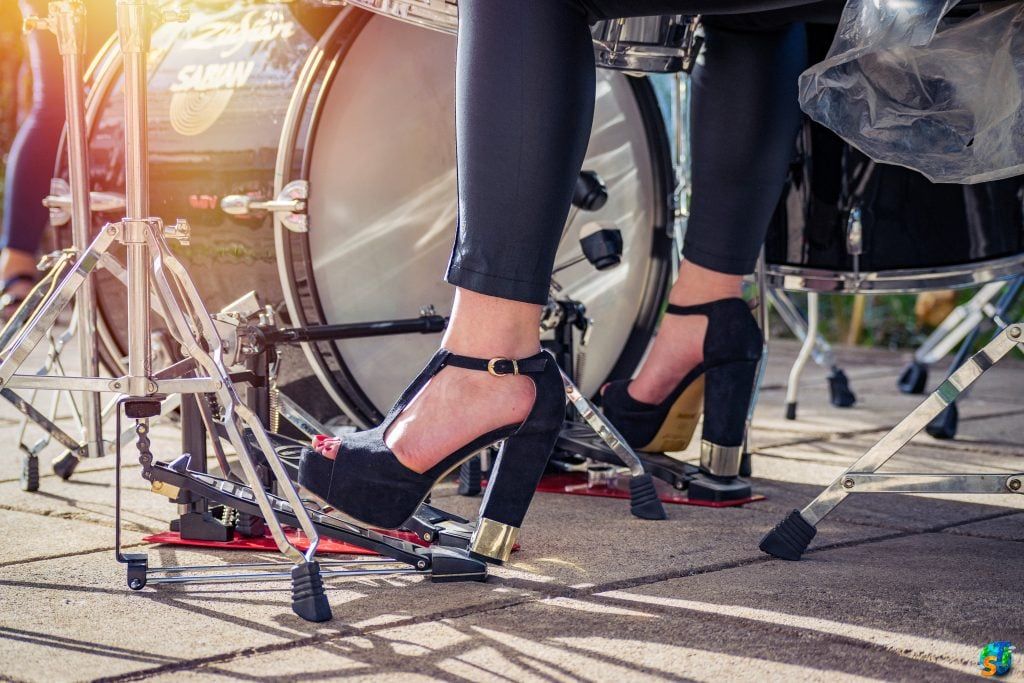Over the years I have seen lots of competent, developing drummers. Many of which have a fantastic sense of rhythm and timekeeping, and display a good overall level of drumming ability.
Whilst being filled with huge potential, lots of drummers are being held back by fairly common bad habits that inhibit a drummer’s optimal level of performance.
These habits are easy to fix but can affect various areas of a drummer’s playing. You might be surprised to see you might be a culprit of one of these common drumming mistakes!
Contents
1. Playing with Wrong-Sized Drum Sticks

Using drumsticks that are too heavy or too light for your playing style can negatively impact your technique and sound.
The size and weight of a drumstick have a huge impact on a drummer’s performance, and whilst there is no “perfect stick” for each individual drummer, there is an optimal balance of weight and playability.
Drumsticks that are too light will be unable to draw out a good sound from the drums. Using drumsticks that are too heavy will have an equally negative effect on your playing as they consume too much energy and impact your speed.
This is a very common issue and one that a lot of drummers are afraid to admit!
There are hundreds of different drumstick sizes out there for you to try. If you are struggling to find the right drumstick size for you, I recommend going to a music shop and experimenting until you find a great fit for your style of playing.
2. Gripping Drumsticks Incorrectly
Having an incorrect grip is a common mistake amongst beginner drummers that can greatly impact your technique and overall playing ability. The grip refers to how a drummer holds the drumsticks, and it is essential for achieving proper control, speed, and accuracy.
There are two primary drumstick grips: matched grip and traditional grip. In matched grip, both hands hold the drumsticks in the same manner, with the palms facing down. This grip is commonly used in styles such as rock, pop, and jazz.
Traditional grip, on the other hand, involves holding the left stick differently from the right stick, with the palm of the left hand facing up. Traditional grip is often utilized in marching band, orchestral, and jazz drumming.
Regardless of which grip a drummer chooses, using an incorrect grip can lead to various issues. Some common mistakes related to grip include:
-
Holding the sticks too tightly: Gripping the sticks too tightly restricts natural movement and can cause muscle tension and fatigue. It also limits rebound, making it more challenging to execute quick and controlled strokes.
-
Holding the sticks too loosely: On the flip side, holding the sticks too loosely can result in a lack of control and precision. It may lead to unintentional drops or inconsistent strikes.
-
Incorrect finger positioning: Fingers play a crucial role in drumstick control. Placing fingers too far back on the stick or not utilizing them effectively can hinder dexterity and responsiveness.
3. Incorrect Pedal Positioning
This is another common mistake that I see lots of beginner drummers falling into bad habits with. As well as inhibiting drumming performance, this also poses a risk to injury if a drummer is playing for extended periods of time.
Maintaining a good drumming posture is essential for allowing you to play the drums at the very best of your ability.
Often I see a drummer having to extend his legs further than necessary to reach pedals, and most commonly the hi hat pedal. This puts a lot of unnecessary strain on the hamstrings and this incorrect technique can lead to injury such as hyperextension.
Both the hi hat pedal and bass drum pedal should be positioned exactly where the feet fall naturally whilst sitting down, resulting in roughly a 90 degree angle between your knee and ankle.
4. Not Practicing With a Metronome
Drummers need to have a solid internal sense of time in order to maintain steady and consistent grooves. It’s one of the most crucial skills a drummer must have!
By practicing with a metronome, drummers train their internal clock and learn to play with consistent tempo and dynamics. Not using a metronome can hinder the development of this crucial skill.
Practicing without a metronome can lead to inconsistent timing, difficulty in staying in sync with other musicians, and a lack of precision in executing rhythms and fills.
Using a metronome during practice sessions helps drummers become more reliable in their timing, and is vital for creating a tight, cohesive sound.
Simply put – neglecting the use of a metronome is one of the biggest mistakes beginner drummers make.
5. Not Hitting the Center of the Drums

This is a drumming mistake that is very common amongst beginner drummers. It seems so straightforward yet it’s something drummers do more frequently than you might think.
Not hitting the middle of the drums is a consequence of inconsistency and sloppy playing, which demands to be corrected and tightened up through effective practice and repetition.
Hitting the edges of the drum skin, or even worse the rim of the hoop, creates a weak and shrill sound that makes it apparent you have made a mistake with your playing.
Playing on a snare drum is when the inconsistencies of your playing become most apparent. Each area on the snare drum produces a different sound; every fraction of space will produce a unique tonal resonance that reveals uneven playing.
Whilst we are not robots, or near-perfect playing machines, it is a significant measure of a drummer’s ability to demonstrate accurate control across a drum set.
6. Overtightening Cymbal Wingnuts
Overtightening cymbals is a big drumming mistake that can have negative consequences on both the sound and lifespan of the cymbals.
Cymbals are designed to vibrate and produce their characteristic sound when struck. When cymbals are overtightened, the natural vibrations are restricted, resulting in a choked sound.
Overtightening cymbals also puts excessive pressure on them increasing the risk of cracks or damage. Cymbals are made of metal alloys that are susceptible to stress fractures when subjected to excessive tension. Over time, this can lead to irreversible damage and render the cymbals unusable.
Therefore, It’s important to find the right balance between secure mounting and allowing the cymbals to resonate freely. This will allow for natural vibrations and resonance.
Allowing the cymbals to flex will preserve the sound quality, longevity, and expressive capabilities of their cymbals, contributing to a better overall drumming experience.
7. Playing with Uneven Dynamics

To play drums with uneven dynamics demonstrates a lack of precision and control on the drum set. This can also be a consequence of a lack of concentration whilst playing drums.
Here’s an example. A drummer might be playing moderately loud in a verse; with a simple 4/4 hi hat beat. But when the chorus kicks in he decides to exert incredible force and play as loud as he can for 30 seconds, before going back to a normal volume.
You might argue that this shows a human aspect within the playing, but it shows disregard for the song, and what the music as a whole might require.
Another example might be a drummer that plays a really solid groove throughout a song, but then decides to go into his exciting fill very tentatively, and as a result plays so quietly that his drum fill is drowned out completely by the rest of the instruments, and it goes to waste.
It’s important to take into consideration the needs of the music, and to play in a manner that demonstrates complete control behind the drum set throughout a song.
8. Overplaying and Excessive Drumming
Overplaying, or excessive drumming, is a common mistake that drummers, particularly those who are eager to showcase their skills, tend to make. Excessive drumming can overpower the music, and overshadow other musicians in a band or ensemble.
Overplaying demonstrates a crucial lack of musical awareness. Particularly when a drummer is focusing solely on showcasing their own abilities, and doesn’t consider how their playing fits within the composition or arrangement of the music.
Ultimately, a drummer who overplays misunderstands the role of the drummer. The drums serve as the foundation and backbone of a song, providing rhythm, groove, and support for the other instruments.
Some drummers mistakenly believe that they need to be the center of attention at all times, leading to excessive fills, rolls, and unnecessary complexity. This is often a result of ego and a desire for recognition.
It’s always crucial while you play drums to serve the music first, and showcase your skills in a tasteful way and at an appropriate time!
Final thoughts
These are all fairly common drumming mistakes that I am bringing to your attention in the hopes that it might bring to light some potential areas of your playing that you might not have considered.
You may also not be aware of some of these points, and believe they might not affect your drumming as much as you think. Correcting these mistakes will significantly improve your drumming performance and allow you to play with more confidence and enjoyment.
All these mistakes can be fixed with a positive attitude, good technique and repetition of practice. The key to improvement is to become aware of weaknesses through realization and then working to correct them through dedicated practice.










